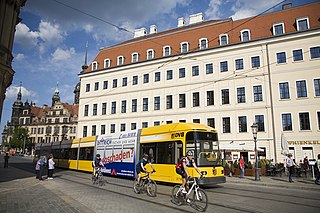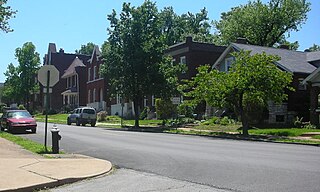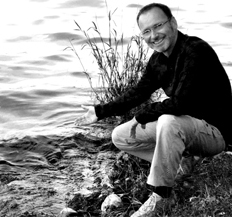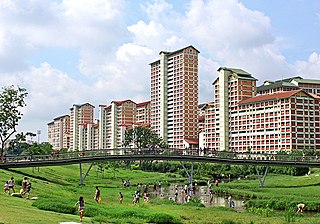
Urban forestry is the care and management of single trees and tree populations in urban settings for the purpose of improving the urban environment. Urban forestry involves both planning and management, including the programming of care and maintenance operations of the urban forest. Urban forestry advocates the role of trees as a critical part of the urban infrastructure. Urban foresters plant and maintain trees, support appropriate tree and forest preservation, conduct research and promote the many benefits trees provide. Urban forestry is practiced by municipal and commercial arborists, municipal and utility foresters, environmental policymakers, city planners, consultants, educators, researchers and community activists.

Frank Lloyd Wright Jr., commonly known as Lloyd Wright, was an American architect, active primarily in Los Angeles and Southern California. He was a landscape architect for various Los Angeles projects (1922–1924), provided the shells for the Hollywood Bowl (1926–1928), and produced the Swedenborg Memorial Chapel at Rancho Palos Verdes, California (1946–1971). His name is frequently confused with that of his more famous father, Frank Lloyd Wright.
Charles Morris Anderson is a landscape architect and fellow of the American Society of Landscape Architects, He is a Principal of the Phoenix-based landscape architecture firm, Charles Anderson Landscape Architecture, which is the continuation of his practice of the Seattle-based firm Charles Anderson Landscape Architecture.

1 Spadina Crescent, also known as the Daniels Building, is an academic building that houses the John H. Daniels Faculty of Architecture, Landscape, and Design at the University of Toronto in Toronto, Ontario, Canada. The building is situated in the centre of a roundabout of Spadina Avenue, north of College Street. Its location provides a picturesque vista looking north up Spadina Avenue; it is an axial view terminus for Spadina Avenue.

Kunshan is a county-level city in southeastern Jiangsu province with Shanghai bordering its eastern border and Suzhou on its western boundary. It is under the administration of the prefecture-level city of Suzhou.

Bioswales are channels designed to concentrate and convey stormwater runoff while removing debris and pollution. Bioswales can also be beneficial in recharging groundwater.

A sustainable city, eco-city, or green city is a city designed with consideration for the social, economic, and environmental impact, as well as a resilient habitat for existing populations. This is done in a way that does not compromise the ability of future generations to experience the same. The UN Sustainable Development Goal 11 defines sustainable cities as those that are dedicated to achieving green sustainability, social sustainability and economic sustainability. In accordance with the UN Sustainable Development Goal 11, a sustainable city is defined as one that is dedicated to achieving green, social, and economic sustainability. They are committed to this objective by facilitating opportunities for all through a design that prioritizes inclusivity as well as maintaining a sustainable economic growth. Furthermore, the objective is to minimize the inputs of energy, water, and food, and to drastically reduce waste, as well as the outputs of heat, air pollution. Richard Register, a visual artist, first coined the term ecocity in his 1987 book Ecocity Berkeley: Building Cities for a Healthy Future, where he offers innovative city planning solutions that would work anywhere. Other leading figures who envisioned sustainable cities are architect Paul F Downton, who later founded the company Ecopolis Pty Ltd, as well as authors Timothy Beatley and Steffen Lehmann, who have written extensively on the subject. The field of industrial ecology is sometimes used in planning these cities.

Sustainable landscape architecture is a category of sustainable design concerned with the planning and design of the built and natural environments.

Daylighting is the opening up and restoration of a previously buried watercourse, one which had at some point been diverted below ground. Typically, the rationale behind returning the riparian environment of a stream, wash, or river to a more natural above-ground state is to reduce runoff, create habitat for species in need of it, or improve an area's aesthetics. In the United Kingdom, the practice is also known as deculverting.

Green infrastructure or blue-green infrastructure refers to a network that provides the “ingredients” for solving urban and climatic challenges by building with nature. The main components of this approach include stormwater management, climate adaptation, the reduction of heat stress, increasing biodiversity, food production, better air quality, sustainable energy production, clean water, and healthy soils, as well as more human centered functions, such as increased quality of life through recreation and the provision of shade and shelter in and around towns and cities. Green infrastructure also serves to provide an ecological framework for social, economic, and environmental health of the surroundings. More recently scholars and activists have also called for green infrastructure that promotes social inclusion and equity rather than reinforcing pre-existing structures of unequal access to nature-based services.

Marco Mario Paolo Casagrande is a Finnish architect, environmental artist, architectural theorist, former mercenary, writer and professor of architecture. He graduated from Helsinki University of Technology department of architecture (2001). Casagrande has been identified as an anarchist architect.

Gravois Park is a historic neighborhood of St. Louis, Missouri. Roughly bounded by Jefferson Avenue, Chippewa Street, Grand Boulevard, and Cherokee Street, the Gravois Park neighborhood is a diverse mix of homeowners, renters, and businesses. The area's architecture reflects its settlement at the turn of the 20th century. The namesake park dates from 1812, and was praised for its beauty in the nineteenth century already, and in 1914 was part of a walking tour of the city meant to show off the City Plan Commission's "idealized view of the shape of the city."
Anita de la Rosa Berrizbeitia is a landscape theorist, teacher, and author. She continues to play an integral role in the renewed visibility of landscape architecture as a cultural practice. She is currently professor of landscape architecture at the Harvard Graduate School of Design and previous chair of the department of landscape architecture. Appointed in 2015, she served as the 14th chair of the oldest landscape architecture department in the world and only the second female to hold the position. Prior to coming to Harvard University she was the associate chair of landscape architecture at the University of Pennsylvania.

Herbert Dreiseitl is a sculptor, artist, landscape architect and interdisciplinary urban planner. He founded the firm Atelier Dreiseitl in 1980 with a vision to develop liveable cities inspired by a deep understanding of water. In 2013, the studio was acquired by the Danish-based international consultancy group and continued under the name Ramboll Studio Dreiseitl. As of 2023, Dreiseitl's office is located in Überlingen, Germany, still a local affiliate of Ramboll. He has taught courses at the National University of Singapore and at Harvard University.
Duke Kunshan University is a university in Kunshan, Jiangsu, China. It was established in 2018 by a joint venture between Duke University and Wuhan University. The university is an independent legal entity.

Ramboll Studio Dreiseitl Was one of the leading landscape architecture practices of Germany specialising in the integration of art, urban hydrology, environmental engineering, and landscape architecture within an urban context. The practise was founded in 1980 by the German landscape architect Herbert Dreiseitl with a goal to promote sustainable projects with a high aesthetic and social value. Today it has offices in Germany, Singapore and Beijing. In May 2013, Atelier Dreiseitl was renamed Ramboll Studio Dreiseitl GmbH and became a partner within the international engineering consultancy, the Ramboll Group A/S, based in Copenhagen.
EDAW was an international landscape architecture, urban and environmental design firm that operated from 1939 until 2009. Starting in San Francisco, United States, the company at its peak had 32 offices worldwide. EDAW led many landscape architecture, land planning and master planning projects, developing a reputation as an early innovator in sustainable urban development and multidisciplinary design.

FORREC Ltd. designs and plans theme parks, water parks, resorts, retail and mixed use developments and visitor attractions around the world. FORREC's clients include Universal Studios, LEGOLAND, Nickelodeon, BBC Worldwide and Six Flags as well as international companies like China's Wanda Group and Chimelong Group, Dubai Holdings, Dubai Parks & Resorts, Meraas Leisure and Entertainment LLC, Singapore Tourism Board and Khazanah Nasional Berhad. FORREC began as a landscape architecture firm in Canada in 1984 and has since added architecture, interior design and graphics disciplines.

Sarah Bekessy is an Australian interdisciplinary conservation scientist with a background in conservation biology and experience in social sciences, planning, and design. Her research interests focus on the intersection between science, policy, and the design of environmental management. She is currently a professor and ARC Future Fellow at RMIT University in the School of Global, Urban and Social Studies. She leads the Interdisciplinary Conservation Science Research Group.

Chulalongkorn University Centenary Park is a 28-rai park located on the campus of Chulalongkorn University in Bangkok, Thailand. It was completed in 2017 to honor the 100th anniversary of the university's founding. Designed by landscape architecture firm Landprocess, Centenary Park was designed to serve as a rainwater detention basin, partially inspired by the late King Bhumibol Adulyadej's monkey cheeks project.















